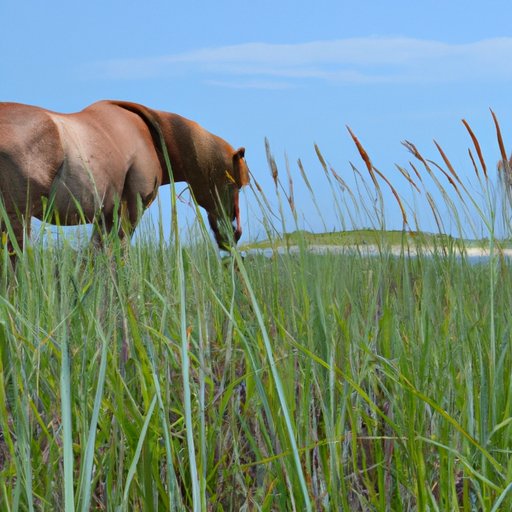
I. Introduction
Corolla, North Carolina, is home to a population of incredible wild horses that locals take pride in. It’s a shame to visit the beach town and miss out on this fantastic opportunity. Although some people are willing to pay for guided tours, not everyone has the budget to see the horses up close. This article ventures to provide a comprehensive guide on seeing the Corolla wild horses for free. From the ideal spots to the best times and respecting the horses, we have you covered.
II. Background Information on Corolla’s Wild Horses
The history of the Corolla wild horses traces back to the early 1500s, where historians speculate that the horses might have descended from Spanish mustangs introduced to the area. The horses traveled up and down the North Carolina coast, and the Corolla herd is now the only existing population of these horses. The culture and habitat of the horses have remained relatively unchanged over the years, although humans have encroached on their territory. It is essential to know the ideal spots to find the horses to protect their traditional habitat while having an unforgettable experience watching them.
III. Ideal Spots to See the Horses
The beaches of Corolla are the best places to spot the wild horses. The horses are fond of walking along the shore as they graze from sea oats and other vegetation that grows on the sand. The northern beaches, specifically the Carova Beach, typically have larger groups of horses compared to other areas.
The best way to see the horses is to drive along the beach, viewing them from a distance. It is advisable not to get too close to the horses to prevent accidents and to respect their natural habitat.
You must note that some areas have off-limit portions, and you need to obtain a permit to access them. Additionally, it’s essential to be aware of the tides as beach driving is only allowed during low tide.
IV. Staying Safe While Exploring the Area
Driving on the beach comes with its risks, and it is crucial to take precautionary measures to stay safe. The North Carolina Beach Buggy Association strongly recommends that drivers use only four-wheel-drive vehicles with low gear settings, high ground clearance, and durable tires. The association also advises drivers to avoid driving on the dunes and restrict beach driving to a maximum of 25 mph.
It’s also important to carry all necessary tools to navigate any situations that may arise while driving on the beach. Drivers should have inflatable air pumps, tow ropes, jack, shovel, fire extinguisher, and a first aid kit.
V. Expert Advice on Spotting the Horses
It’s always better to consult with the experts to learn all about the horses and their habitat. We spoke to locals who have extensive knowledge about the horses and asked them about their insights on spotting the horses.
One tip they shared is to look for groups of birds in the wind or near the dunes. Horses usually move in herds, and birds often flock around them hoping to catch grain or insects attracted by the horses. Also, check out the vegetation; horses like a variety of plants including sea oats, beach pea, and dune heather. Lastly, consider the time of day during low tide, when horses graze on the inner and outer banks of the water along with other vegetation found at different levels of the beach.
VI. Best Times of the Year and Other Wildlife to Watch for
The best time to view the wild horses is during the fall months when the crowds have thinned out, and the temperatures are still warm enough. Alternatively, you can try visiting during the winter months for another opportunity to watch the horses in their natural habitat and witness them adapting to their surroundings. During the winter months, the horses have a longer interaction time with tourists as they seek human structures and handouts for food.
Besides the horses, there are other wildlife species to watch out for while touring the area. The bird population in Corolla is diverse and includes species such as pelicans, cormorants, and seagulls. Visitors may also spot loggerhead turtles and their hatchlings during the nesting season.
VII. Being Respectful When Viewing the Horses
While it’s tempting to want to get a close-up look at the horses, it’s always better to keep a respectful distance to avoid interfering with their lives. To protect their traditional habitat, it’s important to stay on designated roads and driving areas. Do not throw food or litter around, as horses may ingest it and become sick or injured. If you come across any horses that seem injured or sick, it’s advisable to contact the Outer Banks SPCA, the Corolla Wild Horse Fund, or any local animal control agency to report it.
VIII. Conclusion
The Corolla wild horses offer a fantastic opportunity for tourists to enjoy a unique experience at no cost. As highlighted in this guide, with the right equipment, driving across the northern beaches and searching for the horses is a memorable experience. It’s essential to make the most of this opportunity safely and respectfully, to allow the horses to thrive in their natural habitat. So, get ready to have an unforgettable time watching these incredible and majestic creatures in their natural habitat.




